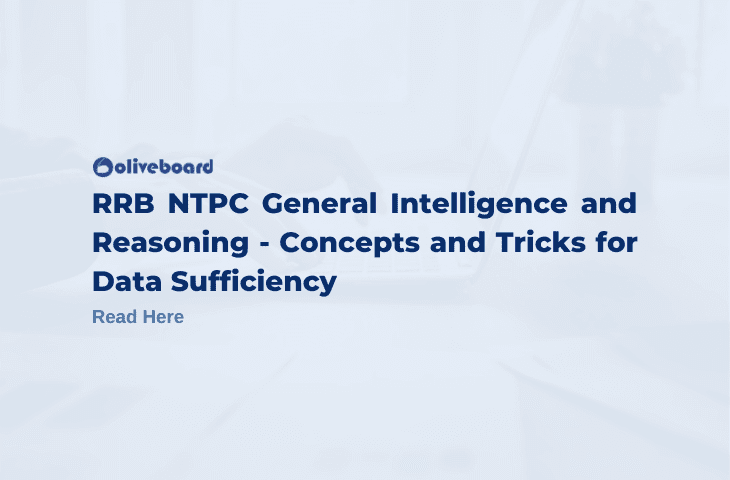General intelligence and reasoning section of RRB NTPC has 30 questions in both stage I and stage II exams. In this section, data sufficiency is a pretty common topic, especially for stage II. In this post, we will discuss some tips on how to solve Reasoning Data sufficiency for RRB in less time and also go through the basic concept.
Attempt a FREE mock test of RRB NTPC
How to approach Reasoning Data Sufficiency for RRB NTPC?
General Intelligence and Reasoning for RRB NTPC is one of the sections which can turn out to be high scoring with maximum accuracy as it includes less calculative skill and more logical skill.
But there is one topic which can take your maximum time and leave you with less time to explore other question and that topic is Reasoning Data sufficiency.
Reasoning Data Sufficiency: The Concept
You will be given a question and you will have to find the solution with the help of the additional data given in two or three statements such that all of the statements may or may not be necessary to find the solution. Basically, you will have to find the solution using the least available data.
Crack any RRB exam: 20+ mocks!
Problems faced by students while solving Reasoning Data sufficiency for RRB NTPC
1. Candidates struggle in making connection between question and statement given.
2. When there is more than 2-3 cases there is chance of skipping cases.
Solutions for the problems faced:
1. Once read the question and statement thoroughly you will get an idea of statement which statements can be linked to get the answer quickly. This will surely save 60% of your time.
For more practice questions of RRB NTPC, click here.
2. Apart from going through the question, going through the options is a time-saver while solving Reasoning Data sufficiency for RRB as well as other exams.
For example, we have three statement in the question and options are like:
(a) All the statement together is sufficient to answer the question
(b) Statement I and II together is sufficient
(c) Statement I alone is sufficient
(d) Statement I and III together is sufficient
So, you don’t have to check option II, III alone and option II and III together which will save your time.
Attempt a FREE mock test of RRB NTPC
3. Practice lot of questions, it will increase your speed and train your brain to find the link(s) between the statements.
Attempt sectional tests on General Intelligence and Reasoning section
Here is an example which can guide you on how to approach Reasoning Data Sufficiency for RRB effectively.
Question: Two statements numbered I and II are given below. You have to decide whether the data provided in the statements are sufficient to answer the question.
Five persons M, N, O, P and Q are of different ages (not necessarily in the same order). No two persons are of the exact same age. Who is the second youngest?
I. M is older than O but younger than P. N is the oldest. Q is younger than P.
II. O is the youngest. P is older than Q but younger than N. M is not immediately older than O.
(1) If the data in statement I alone are sufficient to answer the question while the data in statement II alone are not sufficient to answer the question
(2) If the data in both statements I and II together are not sufficient to answer the question
(3) If the data in both statements I and II together are necessary to answer the question
(4) If the data either in statement I alone or in statement II alone are sufficient to answer the question
Answer key: 3
Solution:
From I alone:
M is older than O but younger than P. N is the oldest. Q is younger than P. We get three cases:
N > P > Q > M > O
N > P > M > Q > O
N > P > M > O > Q
It can’t be determined who is the second youngest. So, statement I alone is not sufficient.
From II alone:
O is the youngest. P is older than Q but younger than N. M is not immediately older than O.
N > P > M > Q > O
N > M > P> Q> O
Similarly, we get other cases in which either P or Q is the second youngest. So, statement II alone is not sufficient.
From I and II together:
M is older than O but younger than P. N is the oldest. Q is younger than P. O is the youngest. P is older than Q but younger than N. M is not immediately older than O.
N > P > M > Q > O
So, Q is the second youngest. Both the statements together are necessary.
Tip: By reading only we can see that both the statement alone will give more than one cases so we just have to check whether combination of both the statement will give the answer or not.
We hope this article will help you prepare better for your upcoming NTPC exam. All the best and keep checking our posts for more such reads.
Download free E-books on RRB NTPC here.
Study at your own convenience anywhere. Download the Oliveboard app now!

The most comprehensive online preparation portal for MBA, Banking and Government exams. Explore a range of mock tests and study material at www.oliveboard.in
